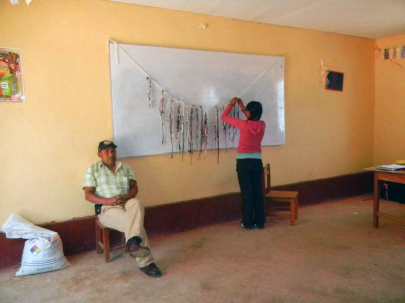
So we have gotten to that time of the year where in my museum studies classes I always ask students to respond to the question below. In this semester’s undergraduate Introduction to Museums course, Brandi Newton, an art history major provided a particularly insightful and compelling response. The question:
Put yourself in the position of John or Josephine Q. Public. In the current economic chaos, the bank is foreclosing on their home, they have lost their jobs, and the city just reduced their public services. In referring to the National Endowment for the Arts and the Institute of Museum and Library Services, the House Budget Committee recently argued that “The activities and content funded by these agencies…are generally enjoyed by people of higher income levels, making them a wealth transfer from poorer to wealthier citizens.” Isn’t your research or the position you aspire to a museum professional just another example of this wealth transfer? What do John and Josephine Q. Public get for their tax dollars that fund your research/position?
Museums: Important Community Assets
by Brandi Newton
In recent years The House Budget Committee stated that museums are essentially nothing more than a wealth transfer from the poor to the rich. If this wealth transfer were to exist then any professional working in a museum would be a participant in maintaining this transfer. In this paper however, I will argue that this wealth transfer either does not exist or is so small that it should not be counted as a loss. I will do this by illuminating the percentage of tax dollars actually used by museums and highlighting the missions of a handful of museums based on educating the public while supporting these claims through examples of funded programs designed to give back, often at not cost, to the community.
Greater than 93 percent of annual not for profit museum budgets are covered by either revenue or private donations leaving less than seven percent to be covered by a combination of local, state, and federal taxes (National Endowment for the Arts 2012). Based on these numbers one could actually argue the opposite of what The House Budget Committee stated. Since private donations from foundations, corporations, and individuals compose 38.2 percent of annual museum budgets, the wealthy are in fact transferring their wealth to the greater community not the other way around. To put this further in perspective, data from 2013 showed that “the $146 million budget of the National Endowment for the Arts (NEA) represents just 0.012% (about one one-hundredth of one percent) of federal discretionary spending” (National Endowment for the Arts 2013:1). This amount of money is a drop in the bucket for federal spending, yet despite their lack of financial support from the government, museums still find ways to give back to their communities.
As described in their mission statement, the National Civil Rights Museum in Memphis, Tennessee seeks to benefit its visitors and community by inspiring “participation in civil and human rights efforts globally, through [their] collections, exhibitions and educational programs” (Stokes-Casey 2014:2). This museum benefits its community by giving back in ways that lead to them exposing more people to what they have to offer; this also works to fulfill their mission statement. One way they accomplish this is by offering free admission days. This of course, allows access for those individuals who could otherwise not afford to attend the museums. Their website states that, “Tennessee residents with state-issued ID may visit the museum for free on Mondays from 3 p.m. until closing” (National Civil Rights Museum 2014).
Additionally, The National Civil Rights Museum’s Education Coordinator, Jody Stokes-Casey has been working with a local charter school to develop a program that teaches the values and history offered in the museum itself. This is a seven-week program that, except for one museum field trip, is actually brought to the school and presented to the students during their homeroom period. The stated goal of one of this program’s resources, which is titled Courage in the Civil Rights Movement is to “enrich their classrooms and to create a resource for teachers to facilitate discussion, encourage student dialogue, increase understanding, and promote courageous action” (Stokes-Casey 2014:4).
There are other ways museums can serve their communities; some do not even require attendance to the museum itself. For instance, The National Museum of American History in Washington D.C. says as a free service “We design and produce a wide variety of teacher professional development workshops and digital learning resources – from short YouTube videos to complex mobile app games, websites, webinars, and electronic field trips” (The National Museum of American History 2015). This type of programming meets one of the goals in their mission statement, which is to “explore the infinite richness and complexity of American history” accomplished through “dynamic public outreach” (The National Museum of American History 2015).
Seeing this museum with its multiple historical exhibits in person is also quite easily accomplished. Barring an individual’s personal transportation and time constraints, this museum in incredibly accessible to the public because, admission is always free. This in itself is quite an awesome service considering the fact that for the majority of museums 40.7 percent of their revenue comes from earned income (National Endowment for the Arts 2012).
Yet another example is the Pacific Science Center in Seattle, Washington whose STEM “Out-of-School-Time…sends teams of high school interns and Science Center educators into underserved communities to inspire students to pursue STEM learning.” This outreach program alone has reached over 150,000 students. After participating in the math portion of this outreach program 70 percent of students saw an increase in their test scores. Their outreach doesn’t begin and end here, in all “The Center’s outreach initiatives serve more than 200,000 individuals spanning over 39 counties and four states, making it one of the top outreach organizations in the Pacific Northwest” (JPMorgan Chase & Co. 2015). It is important to point out that much of the funding for The Pacific Science Center’s STEM Out-of-School-Time program has been provided, not by tax dollars but by a private company. “JPMorgan Chase Foundation has contributed $750,000 [to The Pacific Science Center] over the past 5 years” (JPMorgan Chase & Co. 2015).
I would argue then that public funding be increased because of the measurable and notable benefit that museums are able to provide to their communities. Does a more educated society not benefit us all? In fact, Dr. Anne-Imelda Radice who in 2006 was appointed the Director for the Institute of Museum and Library Services said, “Public funding helps museums deliver quality services that strengthen communities, families, individuals and the nation” (Manjarrez, C., C. Rosenstein, C. Colgan, and E. Pastore 2008:2). This one simple sentence sums up so much of what is important about museums and why they are of such importance in our lives. They provide opportunities for families, friends and colleagues to learn together and create shared memories. However, this benefit can be achieved individually as well. Ultimately, they ensure that our cultural heritage is preserved for posterity so that we may learn from the past. They inspire us as we look toward the future.
References Cited
JPMorgan Chase & Co.
2015 Pacific Science Center: Inspiring a lifelong interest in science, math and technology. http://www.jpmorganchase.com/corporate/Corporate-Responsibility/seattle-pacific-science, accessed March 20, 2015.
Manjarrez, C., C. Rosenstein, C. Colgan, and E. Pastore
2008 Exhibiting Public Value: Museum Public Finance in the United States (IMLS-2008-RES-02). Institute of Museum and Library Services. Washington, DC.
National Civil Rights Museum
2014 Visit. http://civilrightsmuseum.org/visit/, accessed March 17, 2015.
National Endowment for the Arts
2012 How the United States Funds the Arts. Washington, DC.
(http://arts.gov/sites/default/files/how-the-us-funds-the-arts.pdf)
National Endowment for the Arts
2013 Fact Sheet. http://www.nasaa-arts.org/Research/Grant-Making/NEAFactSheetSpring2013.pdf, accessed March 17, 2015.
The National Museum of American History
2015 American History. http://americanhistory.si.edu, accessed March 17, 2015.
Stokes-Casey, Jody
2014 Courage in the Civil Rights Movement. NCRM.












